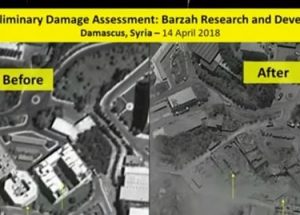
US airstrike on Syria before and after, screenshot from YouTube video
While the purpose of the US strikes was to target Syria’s chemical-weapons capabilities, the relatively modest scale of the strikes are an indication of Russia’s ability to cause Western powers to limit their actions.
The recent US missile strikes on three chemical-weapons sites in Syria represent relatively small-scale action against Syrian President Bashar Assad and underline the extent of Russia’s deterrent posture.
The purpose of the strike was to damage Syria’s chemical-weapons program and to deter the murderous regime in Damascus from unleashing further chemical weapons on the civilian population. Yet in actuality, the strikes are more of an indication of Russia’s success at causing Western powers to limit their actions and opt for extreme caution in their response to Assad’s crimes against humanity.
Russian officials made explicit threats to shoot down US missiles prior to the strike and even to target the missile-launchers. These threats are part of a wider Russian posture aimed at showing the entire world – and the Middle East in particular – that Russia stands by the Assad regime no matter what horrors it unleashes.
Russia’s actions are guided by a cold, hard logic. By standing firm alongside its Syrian client, it is broadcasting the message that any Middle Eastern actor who partners with Russia will gain the essentially unconditional backing of a major power. Between the lines, the Russian message seems to be, “How can you trust the fickle West and the US, which abandon allies or leave them to fight alone? Join our sphere of influence and you will receive real backing.”
This kind of posturing is part of Moscow’s attempt to rebuild its global empire and boost the value of its currency as a superpower ally. There will likely be regional actors who will pay attention to this message.
As for the strikes themselves, they will probably have minimal, if any, impact on overall events in Syria.
The reason the Assad regime uses chemical weapons is because it is engaged in a war against Syria’s Sunni Muslim population, and it is attempting to ethnically cleanse whole areas of communities deemed a threat by the regime.
The Assad regime makes no distinction whatsoever between armed combatants and innocent civilians living in the areas from which the rebels operate, viewing them all as threats to its existence. This is why it repeatedly uses chemical weapons on entire neighborhoods, as well as conventional weapons, committing mass murder and trying to get the rest of the population to flee – preferably, from Assad’s perspective, out of the country.
Already, the Syrian refugee exodus is the worst since WWII. Out of an original population of 22 million people, more than half have left their homes. Of those, half are internally displaced, and around half have left Syria’s borders. The majority of these refugees are Sunni.
The Assad regime is from the minority Alawite sect, an offshoot of Shiite Islam, and the fact that millions of Sunnis are fleeing the country suits it just fine. This strategic shift in the country’s sectarian balance serves Assad’s long-term goal of strengthening its rule. It will continue to work towards this goal by terrorizing and butchering the Sunni population, and by dwindling its numbers by forcing people to leave Syria.
As a result, Europe should expect further waves of Sunni Syrian refugees.
The Assad regime has the backing not only of Moscow, but also of a regional and radical Shiite power: Iran. An array of Iranian-led Shiite armed forces are deployed across Syria, where they oversee the brutal campaign against Syria’s Sunnis.
Striking three chemical-weapons targets in Syria will not change this.
The Iranian-Israeli front
Meanwhile, Syria is also becoming an active combat arena between Iran and Israel. This front is growing more explosive and tense with time. Iran is trying to convert its military assets in Syria into bases of attack against Israel. Jerusalem is showing resolute determination to stop this from happening.
The Israel Defense Forces recently announced that an Iranian drone that flew into Israeli airspace in February and was shot down by the Israeli Air Force was armed with an explosive and was on its way to conduct an attack inside Israel.
This represents the first known time that Iran has attempted a direct armed strike on Israel from Syria, rather than its traditional attempts at organizing attacks via proxy.
The recent reported Israeli airstrike on an Iranian-run military base in central Syria, which purportedly was used by the Iranians to operate drones and threaten Israel, appears to represent Israeli self-defense. The goal is to stop Iran from turning Syria into a forward base of aggression.
In the aftermath of the strike, Iranian officials have been issuing threats of retaliation against the Jewish state.
Israeli defense officials have reportedly responded by saying that if Iran makes good on its threat, the whole of the Assad regime could be destroyed in the subsequent Israeli response.
These events represent a high-stakes struggle between Tehran and Jerusalem, with Iran pushing and testing Israel’s red lines and Israel enforcing them consistently. If Iran pushes too far and disregards Israel’s warnings, this low-profile war could turn into a major regional conflict.
